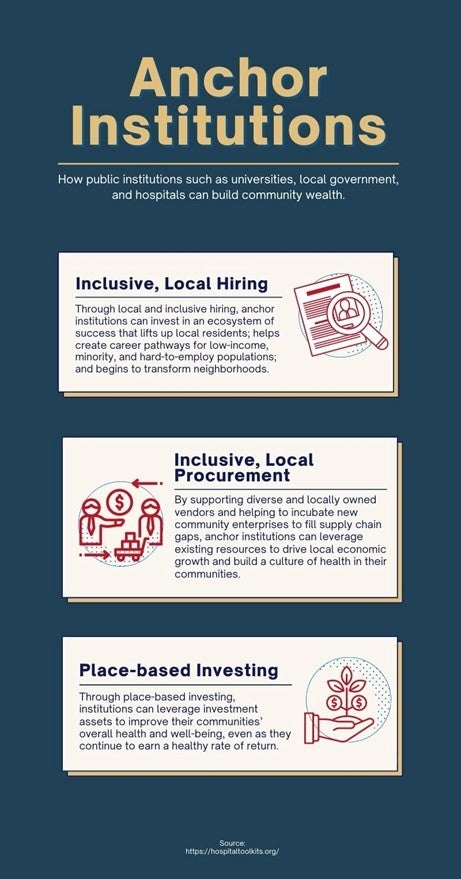Anchor Institutions
What are anchor institutions?
Like County Health, anchor institutions are large place-based and mission-driven entities, often universities, local governments and hospitals that are locked into a community long term and have a significant employment and economic presence in the surrounding community. These institutions can use their significant assets like their hiring and promotion powers, investments capacity and procurement dollars to redress structural inequities and address health disparities.
One example of a collaborative of anchor institutions is taking place in Philadelphia. With the support of the City of Philadelphia and an economic development agency, a collaborative of dozens of anchor institutions that include universities and hospitals came together to leverage their procurement investments to reduce poverty and inequality in Philadelphia’s most impoverished neighborhoods. The initiative called Philadelphia Anchors for Growth and Equity aims to better understand their collective procurement power and supply chains, reduce barriers for disadvantaged small business owners to be able to meet the demand of anchor institutions, and localize procurement as much as possible.
Another example is the Anchor Learning Network, a coalition of 31 urban universities that have adopted an anchor mission and are using their institutional powers to reduce inequities and advance racial equity in the communities they are based on.
Why do anchor institutions matter to health?
The relationship between income and health, and between poverty and poor health, is well established. Financial insecurity makes it difficult to afford and meet basic needs, leading to higher rates of depression and stress, and subsequently more health problems.
The anchor institution model comes out of a recognition that traditional economic development models are increasing inequality which, in turns, undermines population health outcomes. While the modern healthcare system has devoted a lot of time and resources to improving health through quality and access, health inequities persist – and we ultimately treat them at high cost in our emergency departments. San Mateo County is seeing an upward trend across many self-reported chronic conditions: obesity, high cholesterol, high blood pressure, arthritis, asthma, diabetes, chronic obstructive pulmonary disease– all have increased over the past 20 years.
Health Systems across the country are increasingly realizing that these economic determinants of health and structural barriers are negatively impacting their bottom line through increased utilization, delayed discharges due to lack of essential needs like housing, perpetual poor population outcomes and increased cost.
At County Health, as one of the largest employers in the County, we feel like we’re uniquely positioned as a leading economic engine to help improve these conditions.
With the onset of the pandemic and the ongoing economic crisis, the more place-based institutions adopt and implement an anchor mission by levering their hiring, investment and procurement powers, the more likely will be that our local community can navigate and thrive during these challenging times.
Anchoring San Mateo County Health
San Mateo County Health is a member of the Health Care Anchor Network. This is a national network of 50 hospitals and health systems that employ 1.5 million people, purchase over $50 billion annually and have over $100 billion in investment assets. As a network, we are committed to leverage our institutional powers to improve the wellbeing and health of economically disadvantaged communities. This effort aligns with our institution’s mission to
County health is exploring and/or implementing anchor strategies such as:
- Inclusive and local workforce and economic development through designing workforce training/internship programs that specifically focus on minority and low-income residents, for example.
- Inclusive and local sourcing by using purchasing power to build local small business capacity, for example.
- Inclusive capital investments by designating a percentage of discretionary operating dollars to sustainable solutions and place-based investments, for example.
Visit our Current Efforts to learn more about County Health’s anchor mission work. If your institution is interested in learning more about anchor model, please email us at hpp@smcgov.org.
To learn more about these anchor strategies in general the Health Care Anchor Network has developed a toolkit for each:
Inclusive Local Hiring Inclusive Local Sourcing Place-based Investing
Model and Promising Practices of Hospitals and Health Systems Adopting Anchor Missions and Strategies:
- Some cities have re-localized industry in response to COVID-19 describes the efforts by Trinity Health to localize the production of masks for the pandemic by contracting with a local woman-owned and -led company.
- Embracing an Anchor Mission: ProMedica’s all-in strategy describes the institutions journey to learn, embrace and advance an anchor mission that is helping them to better align their institutional resources and clinical practices to address health inequities in their communities. The report highlights ProMedica’s investments in a hospital-owned grocery store in a neighborhood that lacked access to healthy foods and preservation of affordable housing.
- Health care anchors investing in affordable housing to improve health and well-being highlights the $35 million investment in affordable housing projects by CommonSpirit Health, UnitedHealthcare and Aetna.
For more information on Anchor Institutions visit:


